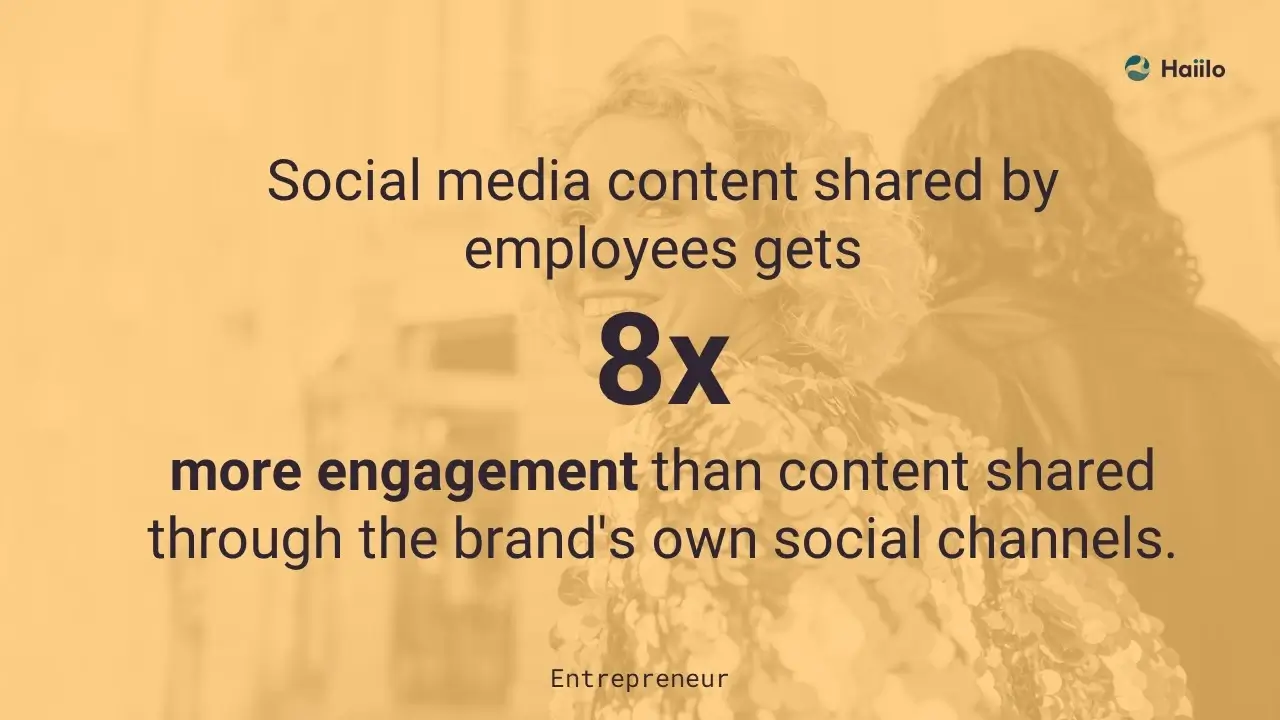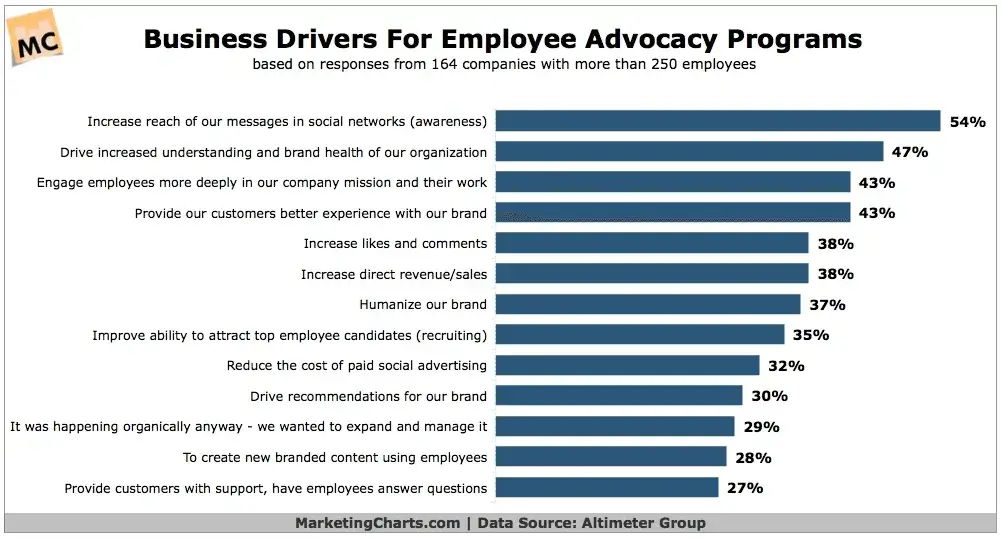
How to: Business Success through Employee Advocacy
How to: Business Success through Employee Advocacy
In this ebook:
- Today people expect information to find them
- Old VS New World
- Employee advocacy is a result of engagement
- The adoption dilemma
- Creating content has zero value
- A bit of magic
- Importance of Employee Advocacy for Marketing and Sales
- Importance of Employee Advocacy for Internal Communications and Top Management
- Importance of Employee Advocacy for HR & Recruitment The revolution is here
- We are Haiilo.
Today people expect information to find them
Let’s face it, our expectations as consumers are at an all-time high. We’re all connected by technology and whenever something relevant to us happens in the world, we expect that information to find us. Whether it’s through our favourite news app and social networks or even through friends and family on direct messaging apps like Whatsapp, we get information just as it happens. And with 88% of people checking their phones within 30 minutes of waking up and the average consumer checking their phone 47 times a day, we’re always informed, always engaged.
Unfortunately, though, this hasn’t really translated into our work lives. The average knowledge worker still spends 2.5 hours a day searching for information. That’s over a week lost every month searching. What does that mean when you take into account an organization with 1,000, 10,000 or 100,000 employees? That’s a massive amount of wasted productivity and a lack of efficient content distribution that still gets overlooked at all levels of the organization; as if we have simply come to terms with this sub-standard practice being the norm.
“The average knowledge worker still spends 2.5 hours a day searching for information. That’s over a week lost every month searching.”
Employee Advocacy is the result of engagement
When employees hit this ‘holy grail’ of information finding them, they are informed, engaged, and much more likely to amplify your company’s voice externally acting as brand ambassadors. Advocacy is a result of engagement. Never the other way around.
We all want our employees to love their jobs, love the company they work for and scream it from the top of their lungs for the world to hear. But guess what, we’re often too short-sighted and we start from the end result. Yes, you can get some results from distributing all your content to all your employees. Call it spray and pray. And yes, some employees will share literally every single one of your posts (some none), but you will be missing out on the biggest advantage of having employees advocate for you which are trust and authenticity. These ‘spammy’ employee-driven shares are easy to spot. Trust and authenticity is built and it only works when it’s real.
What does that mean? The secret lies in thinking of it as a communications channel instead. A channel where you’re connecting relevant content to relevant employees regardless if it’s meant for internal or external sharing. Every day. Anywhere. So they are informed and engaged first. That subtle but meaningful change comes across heavily on the way your employees amplify your messages externally.
The adoption dilemma
How do you get employees to care?
That’s the number one question every single company looking to inform and engage employees asks. In other words, how do you drive adoption and engagement within your entire organization?
Traditionally, content has been segment- ed on whether it’s internal communication content only or externally sharable content. That’s been the norm and how the market has been built. Sometimes, you need to take a step back and challenge the norm: We believe that’s the wrong segmentation approach in the first place. Instead, you should segment content and information based on whether or not it is relevant to the individual regardless of whether it is internal or external.
Let’s start with internal communication materials. Traditionally these include communications meant for employees only, such as:
- Policy updates
- Office information
- Business results
- Personnel updates
- Competitor information
Tools such as internal newsletter and email have long been the primary method of dis- tributing this type of information. While such tools and information are definitely necessary for any given worker, focusing solely on internal has some inherent downsides associated with it:
Engagement
First of all, purely internally oriented tools and news are less engaging in nature. This is because these tools mainly focus on moving communications in one direction – from the company to their employees. There is less in it for the employees themselves, as they are simply the receiver and have little opportunity to influence, share or discuss the information.
Irrelevant info
When a company communicates to a large base of employees, the message they are sharing is bound to reach some people that don’t need that information. For example, if you are an employee located in Boston, you don’t need to know that the bathrooms on the fourth floor of the San Francisco office are undergoing renovation. Internally focused tools are traditionally less focused on segmenting the information based on the right people, and more focused on simply communicating with a group of people at mass.
More about the company than about the employee
Let’s face it – internal comms tools exist primarily to serve the goals of the company. While this is not necessarily a bad thing, it sacrifices user experience and engagement in the process.
On to external communications. These are communications that are meant to be spread outside of the company, such as:
- Company blog
- Employer branding material
- Social media updates
- Job openings
- Case studies, eBooks, whitepapers, webinars
Tools that accomplish this are varied such as marketing automation, social media management tools and traditional employee advocacy platforms. Focusing purely on external also has some drawbacks that need to be considered when creating a holistic communications strategy.
Limited focus
Depending on which department “owns” the platform, the content might revolve mainly around content developed by that part of the business. In these cases, who really de- cides what is relevant to you? You simply get pushed information that your company de- cides is worthy of your time and wants you to distribute it to your external networks.
A tool rather than communications channel
External communications focused tools are thought of as just that – a tool. They are there as a means to achieve an end goal, which often relates to driving traffic or increasing visibility of your brand. While these aren’t bad goals at all, the tool itself becomes an afterthought and runs the risk of becoming gimmicky. In the worst case, people using the tools don’t even read what they are sharing – they simply perform an action in order to send out a message.
When you combine both, and you make it highly relevant and time sensitive, suddenly there is something in it for the employee. It becomes a communications channel to find out what’s happening within the company, regardless of whether it’s internal or external. That’s what employees need to stay in the loop with that’s happening and advance their own personal brands and careers while pushing the business forward.
“Sometimes, you need to take a step back and challenge the norm: We believe that’s the wrong segmentation approach in the first place. Instead, you should segment content and information based on whether or not it is relevant to the individual regard- less of whether it is internal or external.”
Sounds interesting?
Download our eBook and read 11 more pages of useful tips on employee advocacy!



